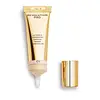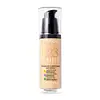Revolution Beauty Revolution Pro Ultimate Coverage Crease Proof Concealer Versus Bourjois Paris Fond de Teint 123 Perfect Foundation for Women
What's inside
What's inside
 Key Ingredients
Key Ingredients

 Benefits
Benefits

 Concerns
Concerns

 Ingredients Side-by-side
Ingredients Side-by-side

Bis-Diglyceryl Polyacyladipate-2
EmollientOctyldodecanol
EmollientCaprylic/Capric Triglyceride
MaskingSilica Dimethyl Silylate
EmollientOzokerite
Emulsion StabilisingTridecyl Trimellitate
EmollientPolyethylene
AbrasiveStearalkonium Hectorite
Gel FormingPropylene Carbonate
SolventTocopheryl Acetate
AntioxidantPentaerythrityl Tetraisostearate
EmollientEthylhexyl Palmitate
EmollientTribehenin
EmollientSorbitan Isostearate
EmulsifyingTrihydroxystearin
Skin ConditioningButylene Glycol
HumectantSodium Chondroitin Sulfate
Skin ConditioningCaprylyl Glycol
EmollientAtelocollagen
Skin ConditioningSodium Hyaluronate
HumectantHexylene Glycol
EmulsifyingPalmitoyl Oligopeptide
CleansingPhenoxyethanol
PreservativeCI 77891
Cosmetic ColorantCI 77492
Cosmetic ColorantCI 77491
Cosmetic ColorantCI 77499
Cosmetic ColorantBis-Diglyceryl Polyacyladipate-2, Octyldodecanol, Caprylic/Capric Triglyceride, Silica Dimethyl Silylate, Ozokerite, Tridecyl Trimellitate, Polyethylene, Stearalkonium Hectorite, Propylene Carbonate, Tocopheryl Acetate, Pentaerythrityl Tetraisostearate, Ethylhexyl Palmitate, Tribehenin, Sorbitan Isostearate, Trihydroxystearin, Butylene Glycol, Sodium Chondroitin Sulfate, Caprylyl Glycol, Atelocollagen, Sodium Hyaluronate, Hexylene Glycol, Palmitoyl Oligopeptide, Phenoxyethanol, CI 77891, CI 77492, CI 77491, CI 77499
Water
Skin ConditioningCyclopentasiloxane
EmollientDimethicone
EmollientMethyl Methacrylate Crosspolymer
Propanediol
SolventPEG/PPG-18/18 Dimethicone
EmulsifyingAluminum Starch Octenylsuccinate
AbsorbentSodium Chloride
MaskingIsononyl Isononanoate
EmollientPEG-10 Dimethicone
Skin ConditioningZinc PCA
HumectantSilica
AbrasivePhenoxyethanol
PreservativeTocopheryl Acetate
AntioxidantCaprylyl Methicone
Skin ConditioningDisteardimonium Hectorite
StabilisingLysolecithin
EmulsifyingChlorphenesin
AntimicrobialDimethicone Crosspolymer
Emulsion StabilisingPEG/PPG-19/19 Dimethicone
EmulsifyingParfum
MaskingAlcohol Denat.
AntimicrobialLauroyl Lysine
Skin ConditioningPropylene Glycol
HumectantDisodium EDTA
Alpha-Isomethyl Ionone
PerfumingPotassium Sorbate
PreservativeSodium Benzoate
MaskingHomarine Hcl
Skin ConditioningAmyl Cinnamal
PerfumingGossypium Herbaceum Extract
Skin ConditioningTriethoxycaprylylsilane
Methicone
EmollientTocopherol
AntioxidantCI 77891
Cosmetic ColorantCI 77491
Cosmetic ColorantCI 77492
Cosmetic ColorantCI 77499
Cosmetic ColorantMica
Cosmetic ColorantCI 77007
Cosmetic ColorantCI 77288
Cosmetic ColorantCI 77742
Cosmetic ColorantWater, Cyclopentasiloxane, Dimethicone, Methyl Methacrylate Crosspolymer, Propanediol, PEG/PPG-18/18 Dimethicone, Aluminum Starch Octenylsuccinate, Sodium Chloride, Isononyl Isononanoate, PEG-10 Dimethicone, Zinc PCA, Silica, Phenoxyethanol, Tocopheryl Acetate, Caprylyl Methicone, Disteardimonium Hectorite, Lysolecithin, Chlorphenesin, Dimethicone Crosspolymer, PEG/PPG-19/19 Dimethicone, Parfum, Alcohol Denat., Lauroyl Lysine, Propylene Glycol, Disodium EDTA, Alpha-Isomethyl Ionone, Potassium Sorbate, Sodium Benzoate, Homarine Hcl, Amyl Cinnamal, Gossypium Herbaceum Extract, Triethoxycaprylylsilane, Methicone, Tocopherol, CI 77891, CI 77491, CI 77492, CI 77499, Mica, CI 77007, CI 77288, CI 77742
 Reviews
Reviews

Ingredients Explained
These ingredients are found in both products.
Ingredients higher up in an ingredient list are typically present in a larger amount.
Ci 77491 is also hydrated iron III oxide. It's sole purpose is to give a red/pink hue to products.
Iron III oxides are classified as inorganic chemicals for coloring.
Synthetically created Ci 77491 is considered safer than those naturally found. This is because the synthetically created version may contain less impurities. Iron oxides are generally non-toxic and non-allergenic.
Learn more about CI 77491Ci 77492 is also hydrated iron III oxide. It's sole purpose is to give a yellow hue to products.
Iron III oxides are classified as inorganic chemicals for coloring.
Synthetically created Ci 77492 is considered safer than those naturally found. This is because the synthetically created version may contain less impurities. Iron oxides are generally non-toxic and non-allergenic.
Learn more about CI 77492Ci 77499 is also hydrated iron III oxide. It is created from mixing red and black iron oxides. This helps give shades of darkness to a product.
Iron III oxides are classified as inorganic chemicals for coloring.
Ci 77891 is a white pigment from Titanium dioxide. It is naturally found in minerals such as rutile and ilmenite.
It's main function is to add a white color to cosmetics. It can also be mixed with other colors to create different shades.
Ci 77891 is commonly found in sunscreens due to its ability to block UV rays.
Learn more about CI 77891Phenoxyethanol is a preservative that has germicide, antimicrobial, and aromatic properties. Studies show that phenoxyethanol can prevent microbial growth. By itself, it has a scent that is similar to that of a rose.
It's often used in formulations along with Caprylyl Glycol to preserve the shelf life of products.
Tocopheryl Acetate is AKA Vitamin E. It is an antioxidant and protects your skin from free radicals. Free radicals damage the skin by breaking down collagen.
One study found using Tocopheryl Acetate with Vitamin C decreased the number of sunburned cells.
Tocopheryl Acetate is commonly found in both skincare and dietary supplements.
Learn more about Tocopheryl Acetate